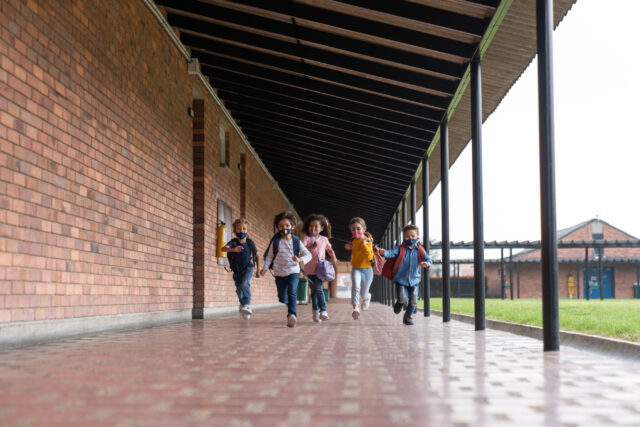Federal pandemic aid and increased state funding have contributed to record K–12 funding levels.
- In 2021–22, state, local, and federal funding for California K–12 public schools was roughly $136 billion, compared to roughly $135 billion in 2020–21 (estimates as of July 2022).
- The federal government allocated $23.2 billion in one-time aid in 2020–21 and another $9.2 billion in 2021–22. Federal funds accounted for 23% of K–12 funding in 2020–21 and 12% in 2021–22. In most non-recession years, the federal share is only 6% to 9%.
- State K–12 funding increased nearly 50% between 2017–18 and 2021–22.
The majority of funding for California K–12 schools is provided by the state.
- Since 1990, the state share of school funding typically has hovered between 54% and 61%, with the local share between 32% and 36%. These shares vary across school districts.
- The state share was lower in 2020–21 (51%) than at any point in at least 30 years.
- In 2020–21 and 2021–22, the state also invested over $5 billion in one-time COVID-19 recovery funds.
California’s per student spending is slightly above the national average . . .
- In 2018–19 (the most recent school year for which we have nationally comparable data from the US Department of Education), spending per student on current operations (e.g., staff, materials) was $14,913 (in 2021$), roughly $1,000 more than the average in the rest of the nation ($13,831 per student).
- California spent less than three of the five next most populous states: less than Illinois and Pennsylvania, and far less per student than the top-spending state in 2018–19, New York ($26,828). California spent more than Texas and Florida, which both spent nearly $10,000 per student in 2018–19.
. . . after per student spending lagged behind most other states for nearly two decades.
- While California currently ranks 19th in spending per student among states (including Washington, DC), its rank ranged between 25th and 35th from the mid-1980s until the recovery from the Great Recession.
- Adjusting for differences in labor costs across states, California’s rank drops to 35th.
- During recessions, California’s K–12 spending typically falls more than spending in other states—but rises more quickly during economic recoveries.
California’s school funding formula allocates additional funding to higher-need students.
- The Local Control Funding Formula (LCFF), passed in 2013–14 and fully implemented in 2018–19, gives districts additional funding based on their share of high-need students (low-income, English Learner, and/or foster youth); districts also have greater spending flexibility under LCFF than in the prior formula.
- LCFF generates a funding target for each district; the state funds what is not covered by local revenue. About 15% of districts are “basic aid”—their local revenue exceeds the target, and they retain these extra funds.
- Under LCFF, 2020–21 per student spending is higher for low-income than higher-income students (by $1,265), for English Learners (ELs) than non-ELs (by $500), and higher for Black and Latino than white students (by $1,278 and $1,185, respectively).
Despite record funding levels, fiscal challenges remain.
- California’s K–12 student enrollment has been declining, largely due to falling birth rates and net migration. Since COVID-19, drops in enrollment have been larger than expected—especially in Kindergarten and grade 1. Most districts and counties will grapple with the fiscal challenges of downsizing over the next decade.
- Increases in personnel costs—such as rising health and benefit costs—can have an outsized impact: roughly 80% of current spending on K–12 students is for staffing (teachers, support staff, etc.). Notably, rising pension contributions absorbed about 25% of the K–12 spending increase from 2013–14 to 2019–20.
- Estimates suggest districts will need at least $7.4 billion in additional state funding for modernization needs through 2025. School facility funding is primarily funded locally, with the state School Facility Program (SFP) providing some support. In part due to a requirement for local matching funds, on average, SFP funding for modernization slightly worsens gaps by district property wealth, student income, and student race.



